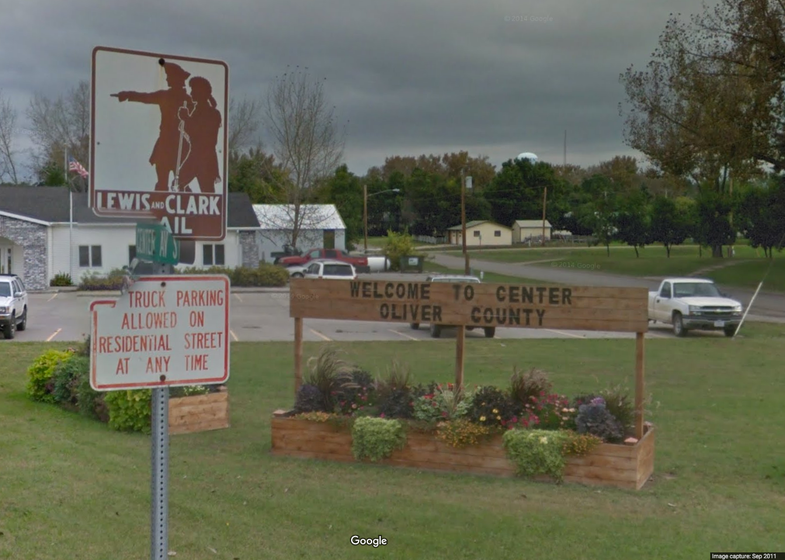The center of North America is a town called Center, and it’s totally a coincidence. Really.
It’s tough luck for the two other towns trying to claim the title

Two towns in North Dakota claim to sit at the geographical center of North America. They’re both wrong. And if it wasn’t for one drunken evening, we’d never even have known.
Rugby, ND has held the official (-ish) title of geographical center of North America since 1931. They sell t-shirts and mugs with that title. They have a “Miss Geographic Center” beauty pageant. Their fall fair is called Geographical Center Day. But the mayor of nearby Robinson, ND didn’t think their claim was good enough—and after a night of drinking, he and some buddies decided to declare that their town was the true geographical center. Actually, not just their town—their bar. This all sounds extremely and totally legit, we agree. Bill Bender is both the mayor and co-owner of Hanson’s bar (nothing fishy about this bar at the exact center of the continent, nope), which now sells its own t-shirts to that effect (so legit). They even stole the expired U.S. patent from Rugby.
This all happened in relative isolation until The Wall Street Journal wrote a story about it in December 2016. Then science got involved.
Peter Rogerson is perhaps the only person to bother calculating the geographical centers of various parts of North America since the United States Geological Survey did it back in 1931. He’s a geographer at University at Buffalo, where he mostly works on population and demographics. He published a paper in August 2015 detailing a new method for calculating geographical centers in which he lays out the precise centers of every U.S. state, plus the contiguous 48 states (the intersection of East 1300 Road and East Mohawk Road in Kansas). He didn’t bother to calculate the geographical center of North America until he read about the dispute in North Dakota.

Rogerson did his calculations using digital records of state boundaries and a computer program of his own invention. The USGS did theirs with cardboard. Literally. They cut out the shape of every state from a sheet of cardboard and then balanced each on a small point. The point where the state-shape was perfect balanced was determined to be the geographical center. Brilliant? Yes. Super-duper accurate? No.
But the two methods are actually closer than you might think. “That’s a physical interpretation of the center,” Rogerson says, he just used a more precise interpretation of the same definition. One of the “fundamental characteristics of centers” is that they minimize “the sum of the squares of the distances to every other point in the region.” Another word for that idea? The average. The mathematical average of a set of numbers is the value that minimizes the sum of the squared distances to every other number in the set. “You can think of the average as the balance point on a line,” Rogerson explains, and it’s the same in three dimensions. The balance point on a cardboard cutout of a state is the 3D average, which is also what we’d call the geographical center. So the USGS had the right idea, even if wobbly cardboard didn’t give them perfectly precise measurements.
Their results have since become the official say on the matter, despite the disclaimer at the top of their memo that they had no good method for calculating geographical centers.

Rogerson’s version is more accurate, and not just because of the lack of cardboard in the methodology. It also takes the curvature of the Earth into account. Two-dimensional maps by their very nature distort what the three-dimensional world looks like, so to distances as accurately as possible Rogerson used a map projection called an azimuthal equidistant projection. The azimuthal projection is perfect if you want to measure distances, because azimuthal maps don’t distort distances as measured from the center of the map. So if you made an azimuthal projection of Pennsylvania, you could accurately measure the distance to anywhere in PA from the geographical center of the state.
With the right map projection and his custom computer program, Rogerson could calculate the geographical center of any area given the proper boundary data. His method changes most of the state centers from the original USGS designations, although about half of them are off by less than two miles—which is pretty impressive for a cardboard-based calculation.
When he read about the warring towns in North Dakota, Rogerson decided to use the procedure from his 2015 paper to figure out which town was correct. That was how he found Center.
The name ‘Center’ isn’t because the founders thought they had any claim to some grand title. Rogerson looked up the history of the name out of curiosity and found that Center, ND is roughly in the center of its county, at least based on the best intel when it was founded in 1902. It may not be in the real geographical center of the county—Rogerson didn’t calculate county centers—but the town probably doesn’t care. “Someone on campus called the mayor of Center, who was apparently very surly, because she wanted to send him a copy of the story when it came out,” Rogerson says, “but he said he didn’t have email.”